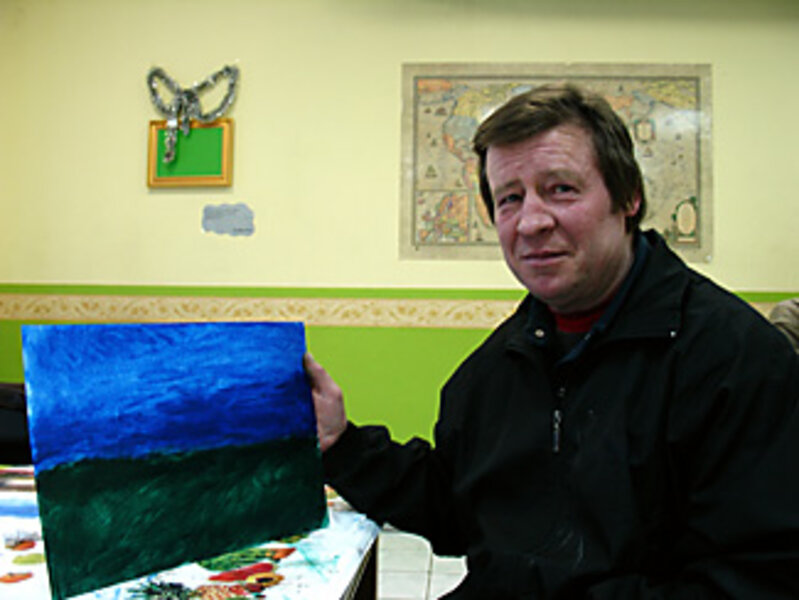Moscow's homeless stage art show
Loading...
| Moscow
It seems an unlikely attraction, but an exhibition of paintings by homeless people in downtown Moscow is drawing media attention to the plight of some of Russia's most vulnerable and disenfranchised citizens.
The artists are among the estimated 100,000 homeless people who daily face police harassment, social hostility, violence, and hunger amid the construction cranes and neon glitz of booming Putin-era Moscow. Last year more than 200 of them froze to death in the streets and, as a New Year cold snap sends temperatures plunging, the toll is climbing again.
Yet some of the childlike finger paintings produced by a small group brought together by social workers from Caritas, a religious charity, exude optimism, or at least hope, in the form of fiery sunrises or tropical islands with flowering palm trees. Others are dark and turbulent. Both styles come from people whose average life expectancy is said to be five years and whose social status is summed up by homeless artist Dmitri Avsinyayev as "official nonexistence."
"Moscow is a rich city, but it's a very cruel place," says Maria Khokhlova, a Caritas organizer. "If you have no registered place of residence, you are nobody. Without vital documents, you can't find shelter, get a job or even pass a police check. You are completely at the mercy of the elements, the criminals, and the police."
Ms. Khoklova works with a group of about 20 homeless artists who meet weekly at the 80-bed Marfina hostel, one of five shelters established by Moscow. Some say they originally joined the art circle because it means a couple of hours off the freezing streets, a warm cup of tea, and a bit of sympathetic companionship.
"It distracts me from my problems and gives me a little breathing space," says Andrei Gyraznov, who lost his flat in a nasty divorce several years ago and has lived on the street ever since. "I never thought I could paint anything at all, and it makes me feel embarrassed when people say they see things in my work."
But the work of Mr. Gyraznov and others – 40 watercolors on display in a small annex of a Moscow bookstore – have received several favorable media reviews and a surge of visitors.
"We've been really surprised to see the public reaction," says Inna Lyapneva, the project curator. "There were 18 mentions of the exhibit on TV, and lots of press coverage. These people are not professional artists, but they touch upon very important themes and their art is sincere."
Gennady Yegorov has been homeless ever since being released from prison 10 years ago. One of his pictures, "The Road to Nowhere," expresses his frustration at having no home, no documents, and very few friends. "This is how I feel," he says, explaining his painting, which shows a path ascending into an endless horizon. "Life is a treadmill. If you have no documents, you can't live or work normally. You can only keep going forward, but there's no destination to aim for."
Despite some liberalization in recent years, Russian law still retains many harsh Soviet-era restrictions that limit freedom of movement. No one is permitted to work or receive social services in Moscow unless they have the vital propiska stamped in their internal passport to prove they have an officially approved place of residence in the city. Even visitors to the capital are required to obtain a temporary registration stamp. They can be arrested and "deported" from Moscow if the police, who strictly enforce the rules, catch them without it.
Many of Moscow's homeless are from out of town, and some have lost their internal passports – the vital identity paper that no Russian ever leaves home without – a predicament that spells a life of constant fear and endless flight from the police. Many end up on the streets after being released from orphanages or prisons without resources to start anew. Others lose their propiska in family disputes, or drift into the streets due to alcoholism, mental illness, or other personal problems.
For all of them, the Russian system can be extremely unforgiving. Even Moscow officials recognize the problem is out of control.
"Practically all our laws are based on [residential] registration, and when a person hasn't got that he's out of the legal field," says Andrei Pentyukhov, head of the Moscow city government's department that deals with the homeless. "We need to focus society's attention on this problem, to find ways to draw these people back into creative life."
Ivan Chernyshev, a former seaman, lost his job, was rejected by his family, and drifted into the streets three years ago. Without a residence, he can't get a new job, rent accommodation, or even apply for a disability pension. "It's my own fault that I lost everything," he admits. "But even if I try now, it seems there's no way out."
Mr. Chernyshev paints seascapes, sometimes with ships, but mostly he depicts stormy waters meeting a dark and threatening sky. "I really miss the sea," he says. "I wish I could go back."
Experts estimate there are 4 million homeless people wandering the new Russia, but there's no way to know the exact number, since public surveys don't reach those without an address.
"To study and resolve the problem of homelessness requires cooperation at many levels, between government and civil society, but we haven't got any of that in Russia," says Grigory Kertman, a sociologist with the independent Public Opinion Foundation in Moscow.





